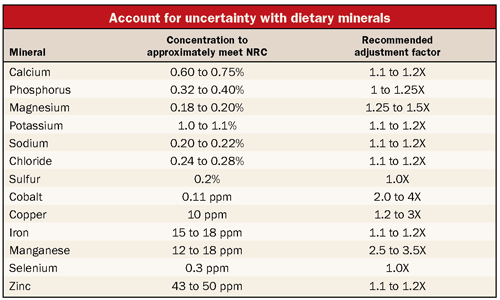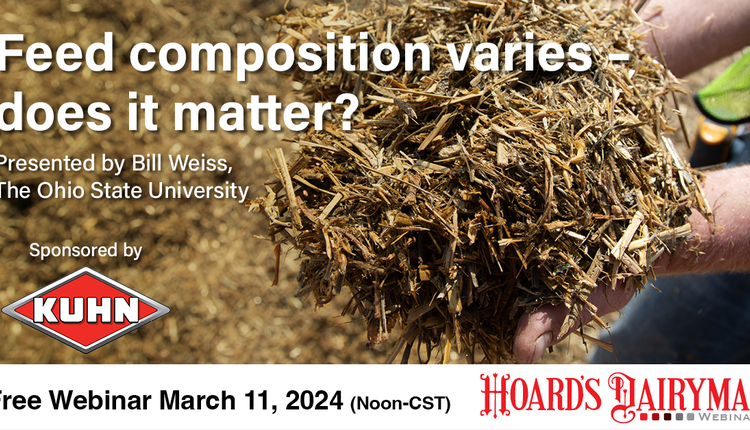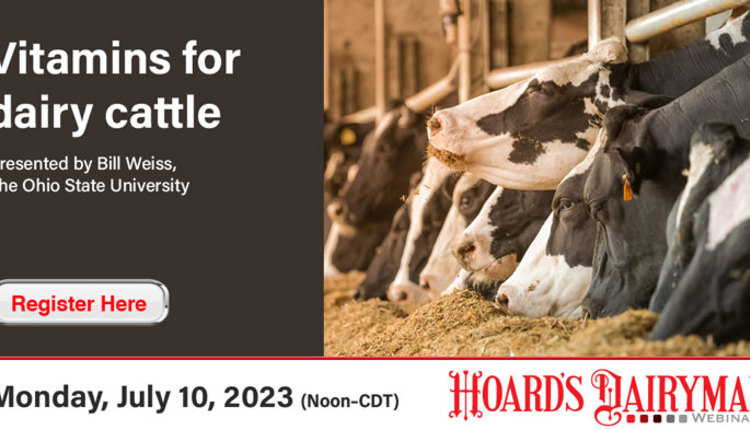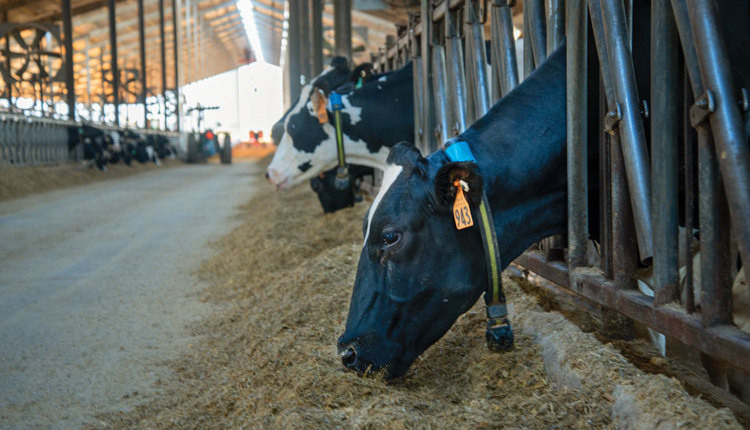The author is in the Department of Animal Sciences, Ohio Agricultural Research and Development Center, The Ohio State University, Wooster.

For good health and high milk yields, cows need to be fed the proper levels of bioavailable minerals. For mineral nutrition, the 2001 Dairy NRC is still the best starting point, but these requirements should be considered as minimums. Scientific data is available showing that feeding less than NRC recommendations often will result in a negative response such as reduced milk yield or poor reproduction.
On average, feeding to meet NRC requirements, with manganese as an exception, will protect against a true clinical deficiency. However, that does not mean deficiencies will not occur or that cows will be in optimal mineral status. Substantial uncertainty exists regarding the quantity of minerals actually consumed, absorbed and needed by the cow in different situations.
This means that we often need to make educated adjustments to NRC recommendations. Diets should be overformulated to reduce the risk of feeding inadequate amounts of bioavailable minerals but not so much as to substantially raise feed costs or have negative effects on the cow or the environment.
Diets should be formulated to provide the maximum legal amount of selenium (0.3 ppm of supplemental selenium). For calcium, sodium, chloride, potassium, iron and zinc, feeding 10 to 20 percent bioavailable mineral above NRC should essentially eliminate any possibility of a deficiency.
That safety factor is based on expected variation in feed composition, cow responses and the lack of any significant real-world antagonists. This degree of overfeeding will not cause any problems and will not have a significant impact on feed costs.
No overfeeding benefits
No valid scientific data exists showing the current NRC requirement for phosphorus (P) is inadequate. But feeding diets with 15 percent less P than NRC recommends has reduced milk yields. Essentially all the P consumed above NRC requirements will be excreted in the manure potentially causing environmental issues.
If you cannot make good use of manure P as a fertilizer, then diets should be formulated to just meet P requirements so we reduce buildup in the soil. However, if adequate cropland that needs P fertilizer is available, manure is applied correctly and all regulations are followed, feeding excess phosphorus is not an environmental negative.
Many by-products such as distillers grains are economical nutrient sources and contain high concentrations of P. If dietary phosphorus is elevated because of by-products, feed costs are often reduced; however, if elevated P is coming from supplements such as dicalcium phosphate, feed costs are almost always elevated. P should be fed to requirement in most situations, but if land resources are available and environmental regulations allow, overfeeding P up to 0.5 to 0.55 percent because by-products are included in the diet can be economically justified.
K reduces Mg absorption
At concentrations commonly found in diets, potassium (K) significantly reduces the absorption of magnesium. This means that meeting the NRC recommendations may not provide enough bioavailable magnesium.
Compared to a diet with 1 percent potassium, the NRC recommendation, a diet with 1.6 percent potassium, which is not uncommon in the field, would need between 1.15 and 1.45 times more magnesium to account for negative effects on magnesium absorption. If you add in the 10 to 20 percent safety factor that accounts for variability, magnesium should be 1.25 to 1.5 times greater than NRC or approximately 0.22 to 0.3 percent of the diet.
Due to the potential benefits of providing extra magnesium such as elevated milkfat and because no adverse effects will be observed until concentrations are greater than 0.6 percent, feeding at the higher rate is a good idea. If using magnesium oxide, make sure it comes from a reputable source because bioavailability varies tremendously among sources.
Water contributes sulfur
Sulfur has not been an issue for most nutritionists and farmers. Basal diets usually contained enough sulfur so supplementation was unnecessary but not enough to cause problems. However, in some locations, water can be a significant source of sulfate-sulfur. When that is considered, cows on those farms can consume enough sulfur to reduce copper and selenium absorption.
For an average Holstein cow, if water contains 350 mg/L of sulfur, that is equivalent to feeding a diet with 0.2 percent sulfur. If your diet is 0.2 percent sulfur and your cows are drinking water with 500 mg/L of sulfate-sulfur, that is equivalent to feeding 0.2 + [(500/350) x 0.2]= 0.48 percent sulfur.
Some labs report sulfate. To convert sulfate into sulfate-sulfur multiply the lab value by 0.33. Diets, including the sulfur in water, with more than about 0.3 percent sulfur reduce the bioavailability of copper and selenium. In some situations, diets with more than about 0.4 percent sulfur have reduced feed intake.
A rapidly emerging source of sulfur is distillers grains. Distillers grains have about 0.35 to 0.4 percent organic sulfur (the sulfur found in some amino acids). Sulfur, though, is often used in the manufacturing process so distillers grains can have 0.6 to 1 percent total sulfur. Using average sulfur concentrations, a diet with 20 percent distillers would contain about 0.3 percent sulfur rather than the typical 0.2 percent.
With the above diet, sulfur, by itself, should not be a major concern. But, if your water also contains some sulfur, the copper and selenium status of your cows could be compromised. In situations where diet and water provide more than about 0.25 to 0.3 percent sulfur, elevate dietary copper by 20 or 30 percent and use a high bioavailable copper source.
Diets (including water) with 0.5 to 0.6 percent sulfur may need to contain 30 ppm or twice NRC recommendations. And the copper should be from highly available sources. Long-term feeding of diets with normal sulfur at 0.2 percent with 40 ppm of copper have caused toxicity (Jerseys are at greater risk for copper toxicity than Holsteins). Diets with high sulfur and 30 ppm copper should be safe, even for Jerseys, because of the poor absorption of the copper. Unless you have good data such as liver concentrations of copper indicating the status is still not optimal, I would not feed diets with more than 30 ppm copper.
High sulfur also reduces the absorption of selenium. Since you cannot legally feed more than 0.3 ppm of supplemental selenium, when you have high sulfur levels make sure a substantial portion of the selenium is derived from a high-quality selenium yeast product. In some situations, selenium injections may be needed, but analyze blood first to check the selenium status of your cows.
Some minerals too low
Studies with cattle conducted after the NRC was published suggest that the NRC recommendations for cobalt and manganese are too low. Positive responses have been observed when diets contained between 0.2 and 0.9 ppm cobalt. Approximately 0.1 ppm is the current recommendation. Because of the uncertainty of response, 0.2 to 0.5 ppm cobalt is a good compromise.

The NRC requirement for manganese is approximately 16 ppm, but a study published after NRC came out showed that feeding the recommended concentration of manganese caused clinical deficiencies in beef heifers. A recent experiment estimated the manganese requirement of lactating Holstein cows at about 30 ppm. Because cows can be fed diets with 1,000 ppm without negative effects, feeding diets with 35 to 45 ppm of manganese poses no risk and will essentially eliminate any potential of deficiency.
Click here to return to the Nutrition E-Sources
130210_91

For good health and high milk yields, cows need to be fed the proper levels of bioavailable minerals. For mineral nutrition, the 2001 Dairy NRC is still the best starting point, but these requirements should be considered as minimums. Scientific data is available showing that feeding less than NRC recommendations often will result in a negative response such as reduced milk yield or poor reproduction.
On average, feeding to meet NRC requirements, with manganese as an exception, will protect against a true clinical deficiency. However, that does not mean deficiencies will not occur or that cows will be in optimal mineral status. Substantial uncertainty exists regarding the quantity of minerals actually consumed, absorbed and needed by the cow in different situations.
This means that we often need to make educated adjustments to NRC recommendations. Diets should be overformulated to reduce the risk of feeding inadequate amounts of bioavailable minerals but not so much as to substantially raise feed costs or have negative effects on the cow or the environment.
Diets should be formulated to provide the maximum legal amount of selenium (0.3 ppm of supplemental selenium). For calcium, sodium, chloride, potassium, iron and zinc, feeding 10 to 20 percent bioavailable mineral above NRC should essentially eliminate any possibility of a deficiency.
That safety factor is based on expected variation in feed composition, cow responses and the lack of any significant real-world antagonists. This degree of overfeeding will not cause any problems and will not have a significant impact on feed costs.
No overfeeding benefits
No valid scientific data exists showing the current NRC requirement for phosphorus (P) is inadequate. But feeding diets with 15 percent less P than NRC recommends has reduced milk yields. Essentially all the P consumed above NRC requirements will be excreted in the manure potentially causing environmental issues.
If you cannot make good use of manure P as a fertilizer, then diets should be formulated to just meet P requirements so we reduce buildup in the soil. However, if adequate cropland that needs P fertilizer is available, manure is applied correctly and all regulations are followed, feeding excess phosphorus is not an environmental negative.
Many by-products such as distillers grains are economical nutrient sources and contain high concentrations of P. If dietary phosphorus is elevated because of by-products, feed costs are often reduced; however, if elevated P is coming from supplements such as dicalcium phosphate, feed costs are almost always elevated. P should be fed to requirement in most situations, but if land resources are available and environmental regulations allow, overfeeding P up to 0.5 to 0.55 percent because by-products are included in the diet can be economically justified.
K reduces Mg absorption
At concentrations commonly found in diets, potassium (K) significantly reduces the absorption of magnesium. This means that meeting the NRC recommendations may not provide enough bioavailable magnesium.
Compared to a diet with 1 percent potassium, the NRC recommendation, a diet with 1.6 percent potassium, which is not uncommon in the field, would need between 1.15 and 1.45 times more magnesium to account for negative effects on magnesium absorption. If you add in the 10 to 20 percent safety factor that accounts for variability, magnesium should be 1.25 to 1.5 times greater than NRC or approximately 0.22 to 0.3 percent of the diet.
Due to the potential benefits of providing extra magnesium such as elevated milkfat and because no adverse effects will be observed until concentrations are greater than 0.6 percent, feeding at the higher rate is a good idea. If using magnesium oxide, make sure it comes from a reputable source because bioavailability varies tremendously among sources.
Water contributes sulfur
Sulfur has not been an issue for most nutritionists and farmers. Basal diets usually contained enough sulfur so supplementation was unnecessary but not enough to cause problems. However, in some locations, water can be a significant source of sulfate-sulfur. When that is considered, cows on those farms can consume enough sulfur to reduce copper and selenium absorption.
For an average Holstein cow, if water contains 350 mg/L of sulfur, that is equivalent to feeding a diet with 0.2 percent sulfur. If your diet is 0.2 percent sulfur and your cows are drinking water with 500 mg/L of sulfate-sulfur, that is equivalent to feeding 0.2 + [(500/350) x 0.2]= 0.48 percent sulfur.
Some labs report sulfate. To convert sulfate into sulfate-sulfur multiply the lab value by 0.33. Diets, including the sulfur in water, with more than about 0.3 percent sulfur reduce the bioavailability of copper and selenium. In some situations, diets with more than about 0.4 percent sulfur have reduced feed intake.
A rapidly emerging source of sulfur is distillers grains. Distillers grains have about 0.35 to 0.4 percent organic sulfur (the sulfur found in some amino acids). Sulfur, though, is often used in the manufacturing process so distillers grains can have 0.6 to 1 percent total sulfur. Using average sulfur concentrations, a diet with 20 percent distillers would contain about 0.3 percent sulfur rather than the typical 0.2 percent.
With the above diet, sulfur, by itself, should not be a major concern. But, if your water also contains some sulfur, the copper and selenium status of your cows could be compromised. In situations where diet and water provide more than about 0.25 to 0.3 percent sulfur, elevate dietary copper by 20 or 30 percent and use a high bioavailable copper source.
Diets (including water) with 0.5 to 0.6 percent sulfur may need to contain 30 ppm or twice NRC recommendations. And the copper should be from highly available sources. Long-term feeding of diets with normal sulfur at 0.2 percent with 40 ppm of copper have caused toxicity (Jerseys are at greater risk for copper toxicity than Holsteins). Diets with high sulfur and 30 ppm copper should be safe, even for Jerseys, because of the poor absorption of the copper. Unless you have good data such as liver concentrations of copper indicating the status is still not optimal, I would not feed diets with more than 30 ppm copper.
High sulfur also reduces the absorption of selenium. Since you cannot legally feed more than 0.3 ppm of supplemental selenium, when you have high sulfur levels make sure a substantial portion of the selenium is derived from a high-quality selenium yeast product. In some situations, selenium injections may be needed, but analyze blood first to check the selenium status of your cows.
Some minerals too low
Studies with cattle conducted after the NRC was published suggest that the NRC recommendations for cobalt and manganese are too low. Positive responses have been observed when diets contained between 0.2 and 0.9 ppm cobalt. Approximately 0.1 ppm is the current recommendation. Because of the uncertainty of response, 0.2 to 0.5 ppm cobalt is a good compromise.

The NRC requirement for manganese is approximately 16 ppm, but a study published after NRC came out showed that feeding the recommended concentration of manganese caused clinical deficiencies in beef heifers. A recent experiment estimated the manganese requirement of lactating Holstein cows at about 30 ppm. Because cows can be fed diets with 1,000 ppm without negative effects, feeding diets with 35 to 45 ppm of manganese poses no risk and will essentially eliminate any potential of deficiency.
130210_91










